During our travels this year, we’ve made it a priority to visit unique natural wonders. Obvious examples are the glaciers in Patagonia and the moonscapes of the Atacama Desert in Chile. When reading about the Fundy Coast of Nova Scotia and New Brunswick, we learned of an uncommon natural phenomenon one might not expect to encounter–extreme tides. What might you consider “extreme?” You really can’t even imagine it unless you see it. How about a tidal rise of more than 52 FEET every six hours. The actually volume and rapid influx and outflow of that amount of water creates some interesting sights. We didn’t spend more than a couple of days in New Brunswick and really can’t tell you much about the province. We used our precious little time there to watch the tide come in. Really, we did. That’s why we went. After you see the pictures and the video, you’ll understand.
One of the best places to experience this unique tidal phenomenon (it really is unique, there is no greater tidal change anywhere else in the entire world) is at Hopewell Rocks Provincial Park. We got lucky in that we were there at full moon and low tide was at 8am instead of the middle of the night when the park is closed. Perfect conditions for seeing the low tide at its most extreme and then return later in the day at high tide. We got up early to make the drive from Sackville (where we were staying) so we could get to Hopewell Rocks before the tide began to rise.
The advantage of visiting Hopewell Rocks is that for three hours on either side of low tide, you can actually walk on the ocean floor and wander below the amazing flowerpot rock formations created by the tides. Masses of tourists gather in a huge parking lot and make the 45-minute hike to the stairs that lead down to the ocean floor. Here’s the view of the stairs after we climbed down and started wandering around in the mud. You can start to get a feel of what that tidal difference really looks like from the cutouts in the cliffs.

Viewed from the top of the stairs, it is even more impressive. You can clearly see where the tidal flow has cut away at the rocks. The bases are covered with seaweed, providing that dark green color and clear indication of the tide line. You can start to get a feel for the 50-foot variation by looking at the tiny people below.
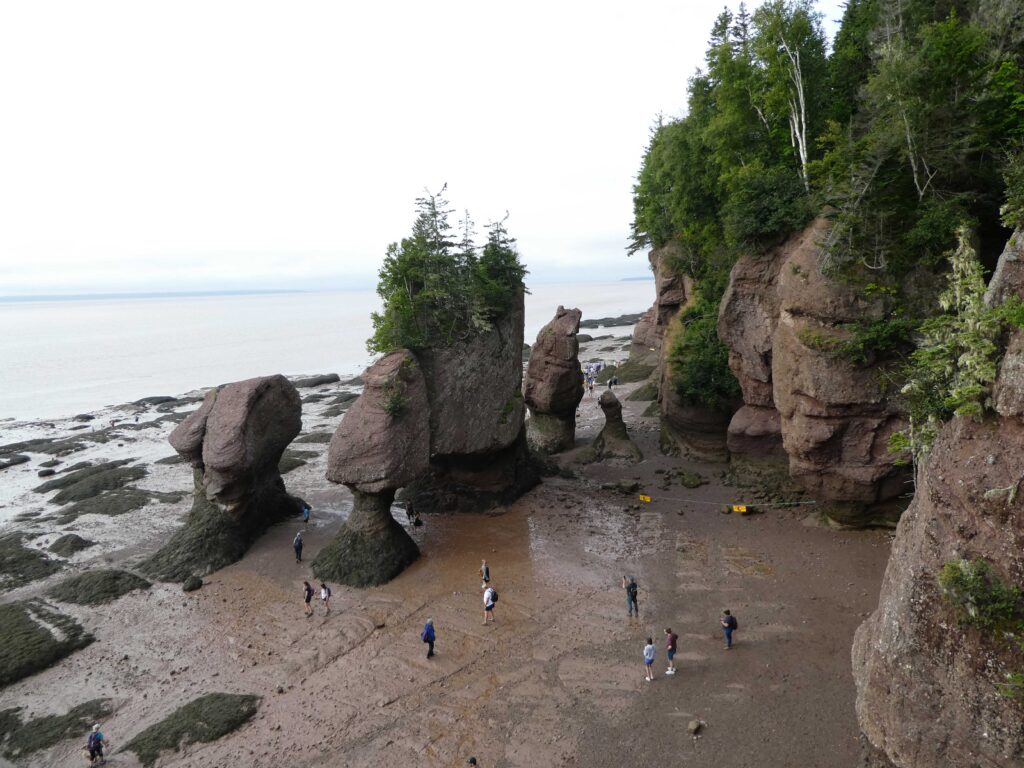
Here are a few more shots taken from below these massive rocks. The water has actually cut these away from the cliff face, kind of the same way the natives of Rapa Nui created the huge heads of Easter Island. In years past, several have toppled and washed out to sea, and some are still being cut away from the rock face.


In this picture, you can see that the tidal flow has eroded the base, but the top of the formation is still attached to the cliff face. It will take a little more erosion from the top and stormy seas at high tide to completely detach it.
The formations are called “flowerpot rocks” because at high tide, they do look like flower pots with plants sticking out the top. If you’re lucky and plan months in advance, you can also kayak around the rock formations at high tide to get the full effect of a 50+ foot tidal difference. We weren’t lucky enough to get on one of those kayak tours, but we did make sure to return later at high tide to get pictures.
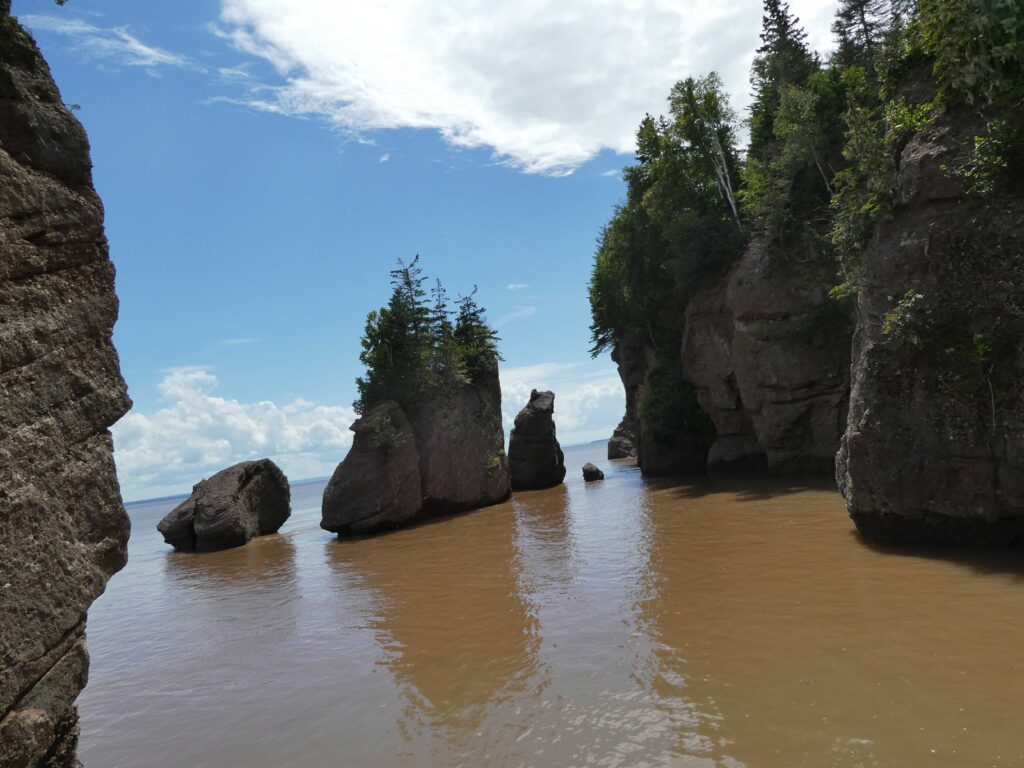
At high tide, you can’t even really tell that these huge rocks are teetering on thin supports. They actually look like tree-covered islands or simply huge rocks impossibly floating on the water’s surface.

Of course, we had limited access to the cliff and could only take a few shots of the high tide from above. There is no access other than kayak at high tide. If you return to the stairs, you immediately find that the lower three sections are completely flooded and roped off.
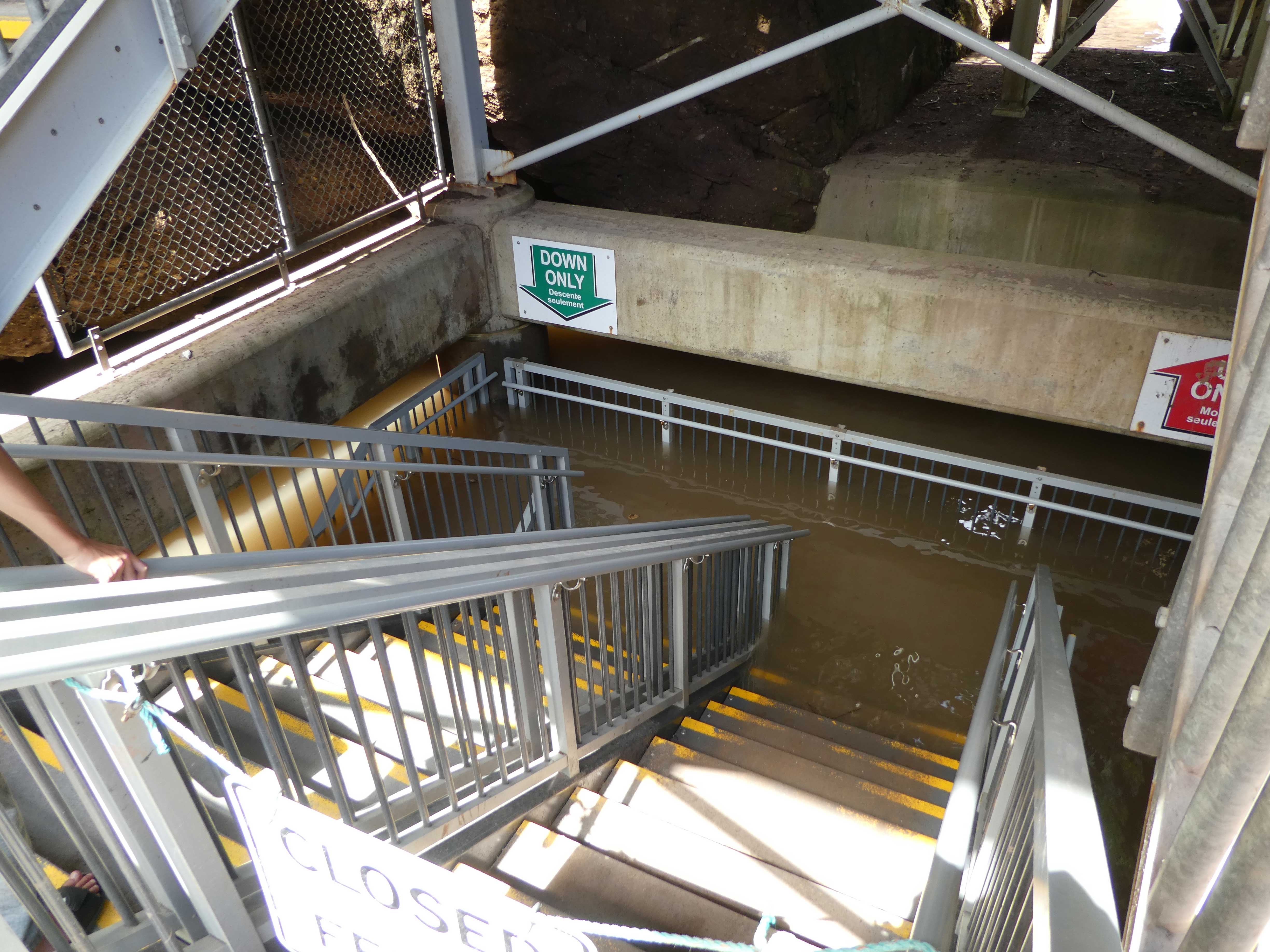
The tides really do create an incredible marker to show you how high they rise after low tide. Standing below the flowerpot rocks makes you feel small and gives a powerful realization of how far under the water you would be during high tide while walking on the ocean floor.
The Tidal Bore
We had some time to kill in between low and high tide, about 5 hours. Obviously We needed to return to the park at high tide to take pictures of the difference. How can you not experience before and after?
In the interim, we drove to the town of Moncton, New Brunswick, to experience another unique phenomenon related to the tides. Because the tidal change is so extreme in such a short period of time, the rising tide creates what is called a tidal bore in the inlets and rivers. One of the best places to experience the tidal bore is in Moncton along the Petitcodiac River. This is such an extreme and unique phenomenon, the good people of Moncton have constructed an amphitheater on the riverbank and pay guides to give presentations on the tidal bore every day before each event. The nearby parking lot fills up as do the rails along the river about half an hour before the scheduled bore.

What is a tidal bore and why could it possibly attract hundreds of people daily to stare out into the river? Incredibly, it is a TWO FOOT wave that runs crashing into town along the river as the tide rises. The wave is so big and so fast that you can actually surf on it! And surf they do. When we were there to witness the tidal bore, there were actually three surfers to help us experience it fully.
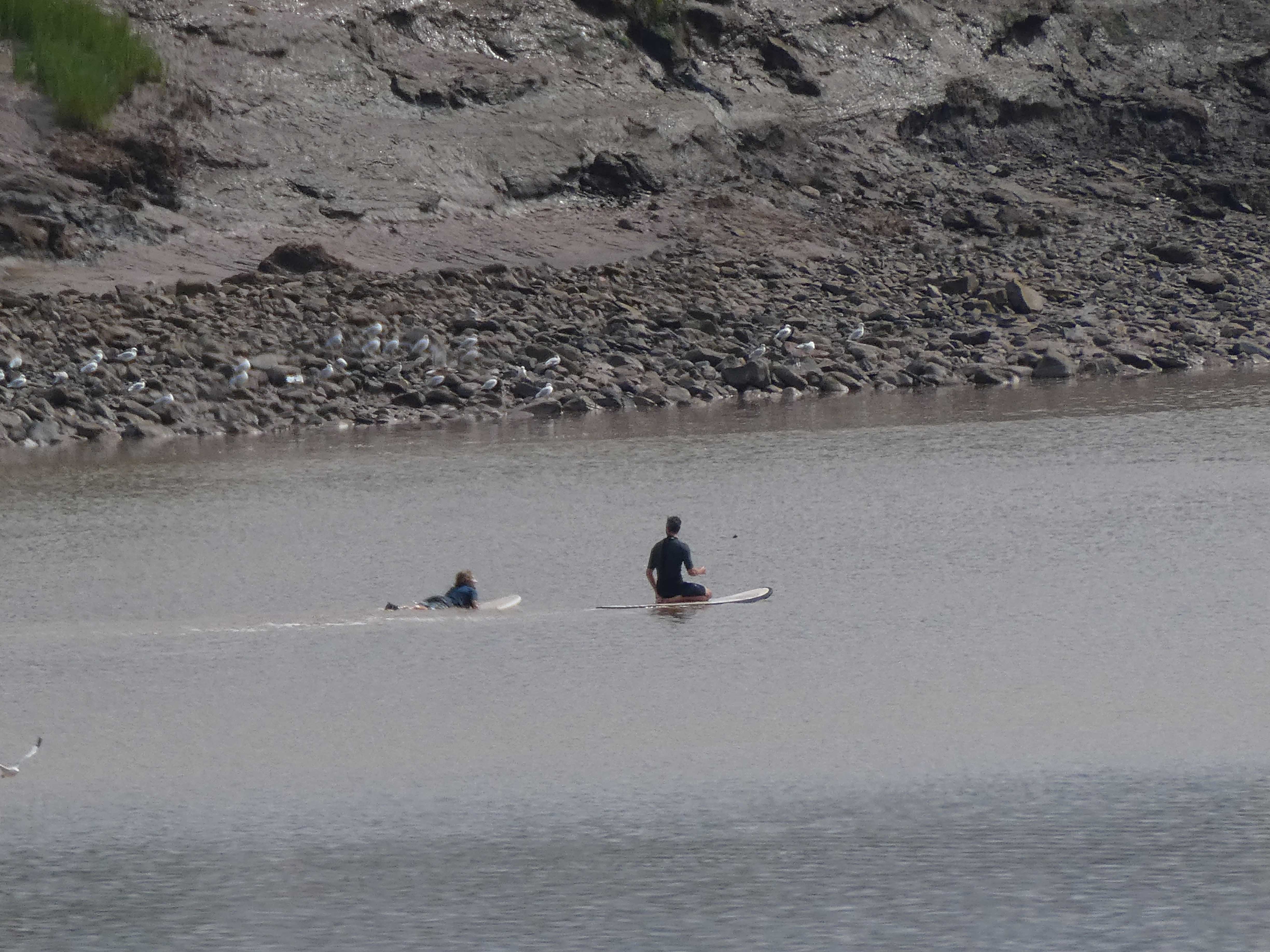
Okay, that’s a pretty big lead up, and I can tell you that many of the watchers were skeptical, as were we, that a rising tide could actually be surfable. Seems extremely improbable. Before we share the amazing video, here’s a still of the wave coming toward us.
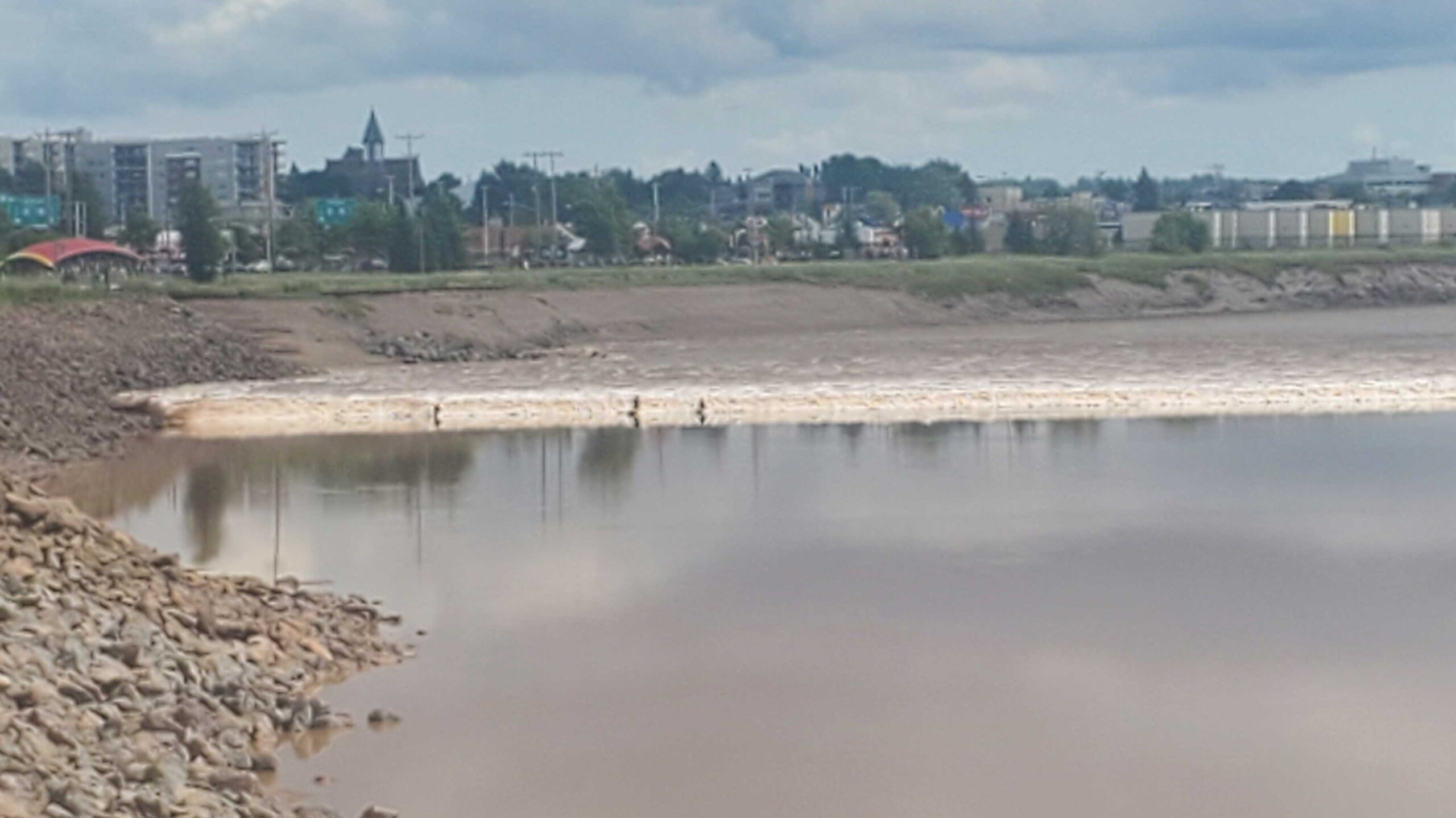
Yes, those dudes are surfing the rising tide. Here it is in full action.
What else is there to say? Tidal bores do happen in other places in the world, but not anywhere else in the Western Hemisphere and not to this extreme. The full video is more than 4 minutes long and really amazing. The most impressive part for me was the water crashing over the rocks along the near bank.
So, with that crazy scene, we’ll end our day in New Brunswick. Apologies to the rest of the province we didn’t get to visit. We just didn’t have enough time with our hard-to-get rental car and wanted to move on to PEI and Newfoundland. We’ll rejoin you from PEI soon. Happy surfing!

Tides are never a bore!!! Beautiful pics! Thanks again and hope to see you two soon!!!
You two do find such interesting things and places. So much fun for me Thanx luv you. 😽🤗
Did you happen to run into any of the Sackville Bagginses while in Sackville? Fun tide photos, both low, high and bore!
The video is sweet! Such an interesting place thanks for sharing. Standing on the ocean floor at low tide sounds thrilling!
There is a bore tide in Turnagain Arm in Cook Inlet, Alaska. Near Anchorage. You should go see that one too! I have seen this area at high tide and low tide but never as the tide is changing. https://www.alaskacenters.gov/explore/culture/nature/bore-tides
I had no idea! That is so cool!